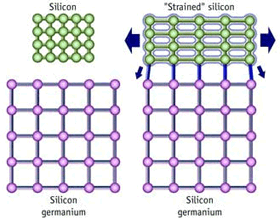Breakthrough in Silicon Technology: Wafer-Level Strained Silicon Technology Announced by SiGen

Silicon Genesis Corporation (SiGen) announced today that it has successfully developed a new wafer-level strained substrate technology, called “Next-Generation Strain” or NGS. NGS features uniaxial strain instead of biaxial strain and avoids the mobility degradation and the high defect levels associated with current silicon-germanium (SiGe) based biaxially strained silicon or strained silicon on insulator (s-SOI). Several chip manufacturers, including Intel and Texas Instruments, have successfully demonstrated the significant benefits of uniaxial strain at the transistor level. Intel pioneered the use of uniaxial strain-enhanced transistor technology and is already using it in its 90nm process. Until today, only local transistor-level uniaxial strain has been available. SiGen is changing that with the introduction of the NGS wafer-level strained substrate.
Francois J. Henley, President and CEO of Silicon Genesis, said, "We are very excited about our new global uniaxial strain technology. This new material offers the potential for significant mobility enhancements over SiGe-based biaxial strain wafer technologies and is compatible with local straining approaches since the strains are additive. It also features very low defect levels due to SiGen’s use of its proprietary low-temperature processing technology. It can be directly integrated on silicon as an “epi-like” strained bulk wafer or on an insulator as a strained silicon-on-insulator wafer (s-SOI). The incremental production costs are expected to be significantly lower than biaxial technologies because it avoids the costly steps of growing and relaxing thick silicon-germanium layers”.
Dr. Scott Thompson, Associate Professor of the University of Florida’s Department of Electrical and Computer Engineering and former Intel Fellow Director of Intel’s 90nm Logic Technology and Strained Silicon Program, commented, “Uniaxial strain is now being recognized as the preferred strain type for deep-submicron device applications, and its local variant has displaced global biaxial strain as the mobility enhancer of choice. Biaxial strain has been plagued with process integration issues such as high defect levels and germanium interdiffusion, but more importantly is much less efficient in boosting PMOS transistor performance. Local uniaxial strain processes are already enhancing 90nm performance at many companies. The availability of a global uniaxially strained substrate can work with these existing approaches to substantially improve total transistor performance and has scaling advantages over local strain at the 45 nm node and beyond. I look forward to the introduction and use of this new technology.”
In line with SiGen’s new IP business model strategy, the company is actively pursuing the development and commercialization of NGS with a number of partners. The company believes there will be significant interest in the NGS technology and that this wafer-level uniaxial strained material will have the potential to become the strained silicon substrate of choice.
About strained silicon
Strained silicon is a very thin layer of single-crystal silicon with built-in strain (stress) to accelerate electrons which allows manufacture of faster devices. Proof that transistors fabricated with strained silicon were faster due to increased electron mobility and velocity was first demonstrated in the mid-1980s.


















